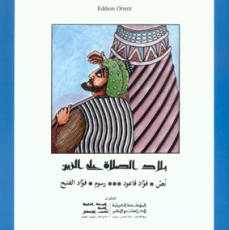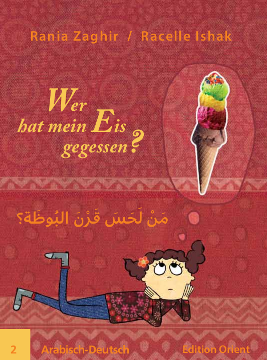Last Revision: 17 March 2024

I have been interested in Arabic children's and youth literature for more
than twenty years. I am looking for excellent children's literature from
the Arab World which should be interesting to a German speaking audience
and I translate children's books from Arabic to German.
The first such book in my translation was also historically the first
Arabic children's book from the Arab World which appeared in translation in a
German publishing house. It appeared 1994 at the German publishing house
Edition Orient with the title:
Die Stadt, wo man sagt: Das ist wunderschön
.
When translating picture books for children, I always keep an eye on the
quality of the illustrations and on the delicate relation
between text and illustration.
I have good contacts to Arab authors, illustrators and publishers and to German speaking publishers of children's literature. I am a member of the German association of literary translators Verband der Literaturübersetzer VdÜ, the Deutsch-Arabische Freundschaftsgesellschaft DAFG, the Deutsch-Jemenitische Gesellschaft DJG, and of the Association for Children's and Youth Literature Arbeitskreis für Jugendliteratur AKJ, which is the German Section of the International Board on Books for Young People IBBY.

Lately I have begun to translate illustrated literature for adults from
Arabic to German: On behalf on the
Goethe-Institute Cairo,
I have contributed to a German-French publication project as follows.
I have translated comics from Arabic by
Messaha (Irak) and by Ahmed Abd El Mohsen (Egypt) and I have translated a comic
from English by Flyin' dutchman (Jordan). The translation of the
graphic novel
Die Wohnung in Bab El-Luk
(The Apartment in Bab El-Louk) by Donia Maher
(Egypt) is also a part of that publication project.
I have translated the first part
of this graphic novel from Modern Standard Arabic to German; this part has
innovative illustrations by Ganzeer (Egypt). The much shorter second part,
which is written in Egyptian dialect and has illustrations in the style of
a classical comic strip by Ahmed Nady (Egypt),
was translated by Rafael Sanchez in close consultation with me.
In his review
The Case of the Arabic Noirs in
The Paris Review
Jonathan Guyer calls the book The Apartment in Bab El-Louk
a hard boiled graphic novella
.
In her Blog Arabic Literature (in English)
Marcia Lynx Qualey has an interview with Ganzeer:
Ganzeer on the Visual Language of The Apartment in Bab El-Louk.
Marcia Lynx Qualey describes The Apartment in Bab El-Louk as a
fabulous noir poem
and Ganzeer remarks:
Donia's text [...] could not
be categorized as a novella, because you don’t have that kind of narration
that is typical of stories. It reads more like a reflective prose of some
sort. Which I feel required a similar visual language to match it, and one
in which the text would be very much be a part of the image.
The Arabic original appeared in 2013 at Dar Merit, Cairo,
and won 2015 the
Kahil Award for Best Graphic Novel.
In 2017 its English translation by Elisabeth Jaquette
appeared as The Apartment in Bab El-Louk at
Darf Publishers, London. Marcia Lynx Qualey
has reviewed this English edition. Maja Ueberle-Pfaff
has translated this review into German, replacing
citations from the English translation with citations from the German
translation which was done for the Goethe-Institute.
I essentially agree with the review of Marcia
Qualey. But I want to add that the format of the book in
its English edition is much smaller than the format of the original (thus
the English edition has many more pages than the Arabic edition),
and that the lettering of the two editions is very different. Unfortunately,
in many cases these changes destroyed the subtle connection between text and
illustration which is typical for the original.
I have published several articles on Arabic children's literature.
Among the publishers are the influential German weekly
ZEIT and the
International Youth Library in
Munich. The International Youth Library
is the largest library for international children's and youth
literature in the world.
The Library prepares a travelling exhibition and a catalogue
called The White Ravens - An Annual Selection of International
Children's and Youth Literature
.
I have a profile on ResearchGate.
In 2021, my survey Arabische Kinderliteratur in deutscher Übersetzung. Den Anfang machte ein Bilderbuch des jemenitischen Malers Fuad al-Futaih about Arabic children's literature in German translation was published in Jemen-Report 2021, Jahrgang 52, Heft 1/2 by the Deutsch-Jemenitische Gesellschaft.
In 2017, my article about Arabic Children's Literature: Between
Tradition and Modernity appeared in Spanish and French
translation in issue 55 of the bilingual political journal Afkar (ISSN 1697-0403).
This journal is edited by the Institut
Européen de la Meditérrranée (IEMed) and appears
in a Spanish version as
Afkar/Ideas and
in a French version as
Afkar/Idées.
This is the Spanish translation of my article:
Entre tradicion y modernidad.
And this is its French translation:
Entre tradition et modernité.
According to IEMed, Afkar is a
quarterly journal aimed at providing ideas from a regional approach
for the neighbourhood between the two shores of the Western Mediterranean
and at promoting debate on the future of societies and Maghrebian
and European countries in particular. Joint publication with
Estudios de Política Exterior (Madrid).
In January 2011 my article on
Arabic
Children’s Literature Today: Determining Factors and Tendencies
appeared at PMLA,
the journal of the
Modern Language Association of America.
(Download of this article from the website of PMLA is restricted to institutions with a subscription of PMLA. Many universities in the USA and abroad
have got the permission to download)
My article
Arabic
Children's Literature Today: Determining Factors and Tendencies
can also be downloaded from the website
JSTOR (JSTOR provides access to more than 12 million academic journal articles, books, and primary sources in 75 disciplines
).
If you have problems with downloading this article,
contact me,
and I will send it to you.
This article was used for example in the course
Writing for Children by
Yasmine Motawy,
which took place in Spring 2012
at the Department of Rhetoric and Composition
of The American University in Cairo.
I have worked for leading Arab publishing houses like The Arab Institute for Research and Publishing (Beirut and Amman) and Dar al-Shorouk (Cairo).
Short descriptions of Arabic books I recommend for translation into German can be ordered by publishers interested in obtaining the rights. I present the books at the following pages (in German):
Several of these books are suitable for different ages. For some, a preliminary translation into German or English is available.
You can find more about those books which have already appeared in my translations from Arabic into German in the German part of my Web site.
This is my recommendation list of children's books from the Arab World which have been translated from Arabic to German (in German).

The Society, registered as a non-profit association in Frankfurt, has set itself these objectives: to monitor literary trends and developments and select the best examples of creative writing from Africa, Asia and Latin America for translation into German, and to promote them in Germany, Switzerland and Austria by encouraging contacts between authors and publishers from the Third World and those in the German speaking region; to serve as an information centre and clearing house about literature from Africa, Asia and Latin America; to help establish and encourage a forum of debate about Third World literature.(from litprom.de)
In autumn 2020, the following picture book from Lebanon appeared in the German publishing house Susanna Rieder Verlag, Munich:
In the publishing house Edition Orient in Berlin four bilingual Arabic-German children's books have appeared with my translations from Arabic into German. The stories are by Fauziya Raschid (Bahrain), Fuad Qa'ud (Egypt), Samira Schafik (=Samira Shafik) (Egypt), Walid Taher (Egypt) and Rania Zaghir (Lebanon). They are illustrated by Fuad al-Futaih (Yemen), Racelle Ishak (Lebanon), Ihab Schakir (=Ihab Shaker) (Egypt) and Walid Taher (Egypt). These books are suitable for Arab and German children alike and they are often used in classroom for German speaking learners of Arabic and for Arabic speaking learners of German. While they are primarily made for the amusement of children, they are useful for adult learners of foreign languages as well. For the prices in Germany, see my list Arabische Kinderbücher in deutscher Übersetzung (in German).

Das ist wunderschön!.
Das ist wunderschön(The Town, where they say:
How wonderful!), bilingual Arabic-German, with a foreword by Petra Dünges, translated from Arabic by Petra Dünges, Edition Orient, ISBN 978-3-922825-57-9, 42 pages, 1994.

Poems for children in bilingual Arabic-German versions in my translation from Arabic can be found in a calendar which is edited by the International Youth Library Munich. This multilingual calendar presents illustrated poems from around the world in the original version together with a translation into German. First, this calendar appeared in the Arche Kalender Verlag, from 2019 until 2022 it appeared as Der Kinder Kalender at Edition Momente, and from 2023 it will appear at Moritz Verlag. In this calendar, which had at first the title Arche Kinder Kalender (Arche children's calendar), poems from all over the world are presented in translations together with the original texts and the original illustrations. For this calendar I have translated an anonymous poem from Lebanon from a collection by Najla Jreissati Khoury (illustration: Hiba Farran, see Arche Kinder Kalender 2017) and a poem from the Egyptian dialect by Salah Jahine (Egypt) (illustration: Walid Taher (Egypt), see Arche Kinder Kalender 2018). Starting from the 2019 edition and until the 2022 edition, the calendar of the International Youth Library Munich was published as Der Kinder Kalender in the publishing house Edition Momente. For Der Kinder Kalender 2019, I have translated an anonymous poem with illustrations by Hiba Farran. For Der Kinder Kalender 2020 and for Der Kinder Kalender 2021, I have translated poems by Salah Jahine (Egypt) with illustrations by Walid Taher (Egypt). The Arabic poem in Der Kinder Kalender 2022 is by Sayed Hegab (Egypt); it appeared in my translation and with an illustration by Walid Taher (Egypt). The Arabic poem in Der Kinder Kalender 2023 is by Salah Jahine (Egypt), illustrated by Walid Taher (Egypt). The author of the Arabic poem in Der Kinder Kalender 2025 is anonymous; it is written in the Tunisian dialect. It is illustrated by Nathalie Novi.
In 30. September 2022, I was invited by the
Goethe Institut Alexandria (Ägypten)
to give an Online-talk, followed by a question and answer session
about Internationaler Übersetzertag: Arabische Bilderbücher in deutscher Übersetzung (= International Translator's Day: Arabic picture books in German translation).
Moderation: Manar Badr, librarian at Bibliotheca Alexandrina.
In November 2016 I was invited to the 13. Hamburger Märchentage (Hamburg Days of Fairy Tales) which had the main subject Märchen aus Arabien (Fairy Tales from the Arab World). I read from my translations and a gave the talk Kinderbücher aus der arabischen Welt in zweisprachigen Ausgaben, nicht nur für arabische Kinder (Children's Literature from the Arab World in bilingual editions for children in Germany). The talk took place in the children's library of Hamburg Kinderbibliothek Hamburg (Kibi) and the audience were librarians, educators and teachers.
In May 2013, I gave the talk Nicht nur für Migrantenkinder: Zweisprachige Bilderbücher aus dem Arabischen(= Not only for children of migrants: Bilingual picture books translated from Arabic ) at the International Congress Multilinguism creates opportunities - continuity in education and training , which took place in Saarbrücken, Germany.
In November 2011, I took part in the workshop Umgang mit Kinderliteratur im Klassenzimmer: Fragen nach Mehrsprachigkeit und Übersetzungen (Children's Literature in the Classroom: Multilingualism and Translations) of the faculty of German Studies at the Unversity of Siegen. I gave a talk on Zweisprachige Bilderbücher aus dem Arabischen: Ein Bericht aus der Praxis einer Übersetzerin (Bilingual Picture Books, Translated from Arabic: Experiences of a Literary Translator). The workshop has been organized by Gesa Siebert-Ott, Jana Mikota, Sabine Planka (all from the Unversity of Siegen).
In June 2011, I took part in the workshop Mehrsprachigkeit und Kinderliteratur (Multilingualism and Children's Literature) at the University of Mannheim. I gave a talk on Zweisprachige Bilderbücher aus dem Arabischen: Ein Bericht aus der Praxis einer Übersetzerin (Bilingual Picture Books, Translated from Arabic: Experiences of a Literary Translator). The interdisciplinary workshop has been organized by Bettina Kümmerling-Meibauer (University of Tübingen), Ira Gawlitzek (University of Mannheim) and Rosemarie Tracy (University of Mannheim).

In September 2010 in Marburg, I gave a talk on Arabic children`s literature and its translation into German at the 31. German Congress of Oriental Studies (DOT) in the section Arabic Language - Literary Translation. This talk was supported by the Deutscher Übersetzerfonds.
Apart from my interest in Arabic children's literature I am a Ph.D. student at the group for Computational Linguistics of the Department of Language Science and Technology of the University of the Saarland in Saarbrücken. My research interests for my Ph.D. are in the area of logic and formal semantics of natural language. The subject of my thesis is On the Foundations of Temporal Discourse Representation Theory.
In 1989 I got a degree in physics from the faculty of physics of the Johannes Gutenberg Universität Mainz: I am Diplom-Physikerin. A Diplom is roughly comparable to a Master of Science. My diploma thesis was written in the group for Theoretical High Energy Physics (ThEP) (formerly called: Theoretical Elementary Particle Physics) at the chair of Prof. Martin Kretzschmar about a subject of mathematical physics, namely Der Dirac-Operator über semiriemannschen, raum- und zeitorientierbaren Spinmannigfaltigkeiten von beliebiger Dimension und beliebigem Index. I still like it.
And I have worked as data base administrator for ADABAS and system manager in a VAX cluster of 50 machines at Hottinger Baldwin Messtechnik (HBM) in Darmstadt. HBM is now part of Hottinger, Brüel and Kjaer (HBK). Today I am reduced to system management on my own computer, but I always like the adventure when I update to a new linux version.
I learned about the beauty of the Arabic language at the then Seminar für Orientkunde of the Johannes-Gutenberg-Universität Mainz. My teacher was Prof. Heribert Horst, who advised me to read a lot. I am still following his advice.
© 2004-2024 All rights reserved, Petra Dünges